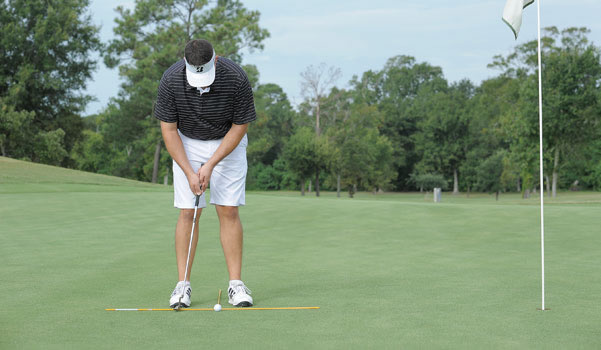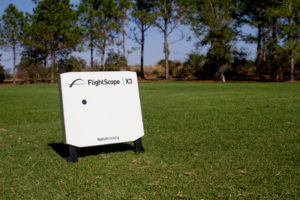Golfers are always looking for ways to improve their swings to help lower their scores, but what they should be focusing on are ways to improve their putting, especially when putting consumes about 40% of the strokes during a round. The greatest challenge in putting is that there is no one set way to putt effectively. There are hundreds of different setups and methods to putting. There may be no single element of the overall putting technique that every great putter is in agreement on. So to help with all of the different variables in putting, there are three things that must remain constant: constant pressure with the hands and fingers, equal distance that the putter goes back and through the ball and consistent speed throughout the stroke (never decelerate).
Golfers must practice and devote themselves to a technique that fits their own personality and physical attributes. With practice, anyone can develop a solid, repetitive, mechanical stroke. Beyond perfecting a mechanical technique, a successful putter must also have the ability to judge slope, sensitivity to feel the proper speed, and the courage to act on his decision. Simply stated, in order to make a successful putt one must roll the ball on the correct path, and do so at the right speed. To start the ball on the correct path, one must be able to read the green correctly. To read the green correctly, one must be able to determine the slope of the green, green speed, grain, and length of putt. On top of reading the green correctly, the ball must then be struck with the right face angle at impact or having the putter face square to the correct starting line.
To help setup for a successful putt, you need to have a comfortable grip that can be repeated every time. As I mentioned before, there are multiple ways to setup and multiple methods to putting. One grip that is popular to many touring pros is the reverse overlap grip, which puts the entire right hand on the grip and brings the two hands quite close together to better work as one unit. Other variations of the grip are the overlap, interlock, ten-finger, split-handed, cross-handed, left-handed, finger-down-the-shaft, and hands-overlapped. The advantage of the cross-handed and split-handed is that the left wrist is less likely to collapse in the forward stroke. Keeping the left wrist from breaking down is necessary in maintaining a repeatable stroke and controlling the putter face angle. Because whatever the back of the left hand is doing during the stroke is going to dictate what the face of the putter is doing at impact.
Next, position your body in a taller posture than older traditional ways to allow for a longer arm hang. This produces a natural grip that finds both thumbs pointing more down the shaft. Because the player stands closer to the ball and the lie of the club is more vertical, the grip will run more diagonally across both the left and right hand. By standing closer to the ball, it makes it easier for the player to position his/her eye line over or slightly inside the ball. This new posture helps to reduce wristiness and clubface rotation.
After you have found a grip and setup that is comfortable, the grip pressure must remain the same throughout the putting stroke to help the player develop a feel for distance with the same grip each time. If you maintain the same grip pressure, it will make judging how far to take the club back and through the ball much easier, which will then help with developing distance control.
Now you need to practice. To help gain confidence in your new grip and setup, practice putts starting a foot away from the cup and make putt after putt until it becomes natural and effortless. Then start to back away from the cup and repeat making numerous putts. To help with lag putts and finishing them off, practice putts from thirty feet and three feet.
Take a look at how many putts per round you currently have. Let’s say you fluctuate between 34 and 38 putts per round. How much time are you currently putting into your practice routine for putting? Five to ten minutes before you tee off? If you fall into this category, you can drastically improve your putts per round if you can commit to practicing your stroke. Let’s take your warm-up routine when you reach the golf course; say you arrive at the golf course 45 minutes before you tee off. Instead of hitting balls and loosening your muscles for 30 to 35 minutes and spend 10 to 15 minutes on putting, let’s reverse the routine. Devote 25 to 30 minutes of your warm-up routine to practicing your putting stroke, and leave 15 to 20 minutes to hitting balls and loosening your muscles. You shouldn’t try to find a swing on the driving range; you should be trying to loosen your muscles so that you can swing the golf club. If you can’t find your swing on that day, you now have practiced your putting to help compensate for bad golf shots.
Take a look at the top 100 players on the PGA Tour at the end of the 2011 Season: Kevin Na leads the tour with the fewest putts per round average at 27.75 putts per round and Keegan Bradley sits in 100th spot with an average of 29.26 putts per round. Tour players practice their putting more in one or two days than the average golfer does in an entire month. If you were to practice more than just before you tee off, you could easily drop down to between 28 and 32 putts per round. How would you like to drop an extra 6 to 10 shots per round off your scores? Practice with a comfortable setup and grip, and manage the three things that must remain constant: constant pressure with the hands and fingers, equal distance that the putter goes back and through the ball and consistent speed throughout the stroke (never decelerate).


 (@manoloteachesgolf)
(@manoloteachesgolf)